PB-7 floating armored car
The first experienced PB-4 armored cars were built by the fall of the 1933, and were soon put to the test. Later the project was reworked, and three more prototypes appeared. This technique was tested before 1935-36's, and the results of the checks were not encouraging. Ride quality armored cars on rough terrain left much to be desired, as well as performance when driving on water. Further improvement of the machines did not make sense. They were abandoned in favor of a completely new model.
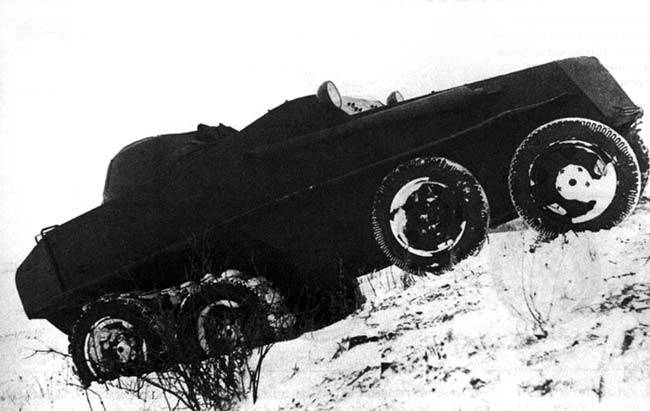
Armored car PB-7 on rough terrain. Photo Aviarmor.net
In the middle of 1936, the design office for modernization (KBM) of the Izhora Plant (Kolpino), together with several related organizations, was engaged in the development of the next floating armored car. The project called PB-7 was created under the leadership of designers Drabkin and Ilyichev. When it was created, it was planned to use the experience of working with both floating armored cars and exclusively ground vehicles.
One of the main problems of the PB-4 armored car was the unacceptable ratio of engine mass and power. There were also problems with the design of the chassis. Thus, the new PB-7 should have received a large number of new units. All its main elements needed to be re-created, retaining only individual nodes.
PB-7 was proposed to build on the basis of the bearing welded hull of complex shape, assembled from armor plates with thickness from 8 mm (forehead, sides and stern) to 4-5 mm (roof and bottom). The layout of the internal compartments corresponded to previous projects: the power plant was placed in a relatively compact front compartment, and all other volumes were allocated for placement weapons and crew. Past projects have shown that the powerplant and chassis of the Ford-Timken truck do not correspond to the tasks to be solved. In connection with this, the source of parts for PB-7 has become the domestic truck GAZ-AAA.
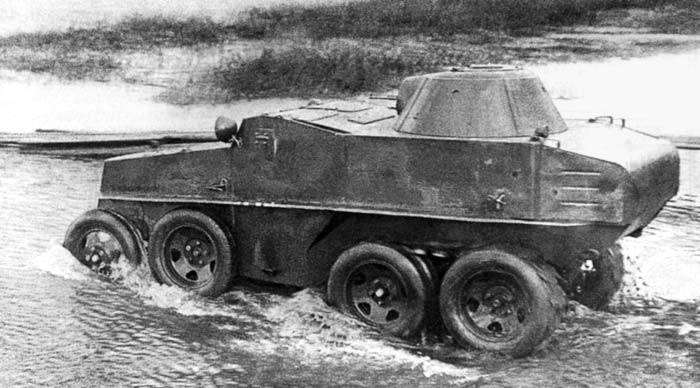
Launching. Photo by Alternathistory.com
New armored hull differed less complex form. The engine was covered with a curved frontal sheet, a pair of diverging sides, as well as a horizontal bottom and a sloping roof. In the latter there were hatches for ventilation and maintenance. The expanding sides of the engine compartment smoothly passed into the walls of the habitable compartment. Above the hood, respectively, was a front sheet with inspection hatches. In the central part of the board were divided into two parts. The lower one formed a box-like unit with mounts for the rear axles, while the upper one was part of medium-sized niches. The stern had a complex shape formed by several curved and straight details.
A characteristic feature of the amphibian PB-7 was a curved roof. Above the driver’s and commander’s workplaces there was a kind of cabin that rose above the level of the main part of the roof. At the last was a chase for the tower.
Armament proposed to mount in a conical armored turret. This unit was developed specifically for the new armored car. The tower consisted of several curved sheets placed with a large slope inward. In the frontal detail there was a large influx of machine-gun installation: a device of a complex rounded profile with a movable inner mask was located on a rectangular opening. On top of the dome there was a horizontal roof.
Under the armored hood, it was proposed to mount the M-1 carburetor engine with 50 horsepower. production of the Gorky Automobile Plant. Next to the engine were fuel tanks. The exhaust pipe with a silencer was brought to the starboard and placed in the upper part of the hull. The engine was connected via a disk clutch with a four-speed gearbox with a multiple ratio gearbox. With the help of a cardan shaft passing through the gland in the bottom of the case, torque was applied to the worm gears and the bevel differentials of the two rear axles. Also, the longitudinal shaft through a separate transmission is connected to the propeller.
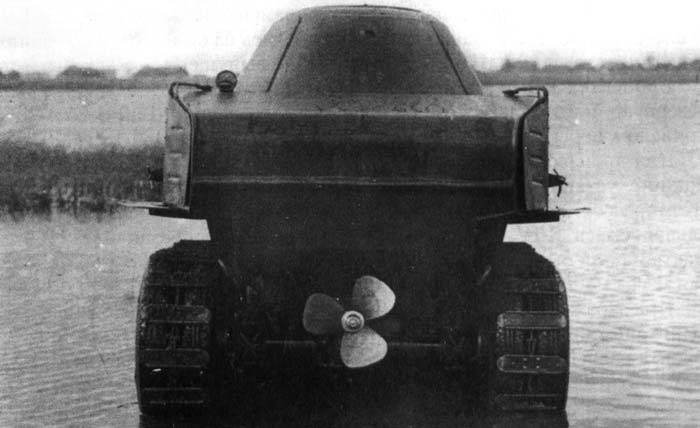
View of the stern. Photo Aviarmor.net
According to the experience of the previous project, the original engine cooling system was used. The standard radiator of the M-1 motor was replaced with a larger T-37 type device with a capacity of 18 l, equipped with an increased fan. When driving over land, the air entered the radiator through a hatch in the frontal part of the hull, closed when launched. Also under the bottom appeared a heat exchanger in the form of a bent pipe, with which the engine could be cooled with seawater.
The undercarriage was used with the formula 6х4. In front of the car put the axle with steered wheels. His suspension was built on a semi-elliptical transverse spring with 17 sheets. Two rear axles with longitudinal springs and jet rods were combined into a kind of carriage. Used bulletproof tires. If necessary, it was possible to wear Overall track chains on the two rear wheel pairs. Like the PB-4, the new armored car received a pair of spare wheels with mounting on the sides, behind the front axle. When driving on rough terrain, they served as an additional support and increased maneuverability.
Above the wheels along the sides, shelves were installed that ran along the entire length of the hull. The designers decided not to equip the new armored car with separate mounted floats, similar to those used in the PB-4 project.
In the stern of the machine was a three-bladed propeller driven by a worm shaft rear axles. For the first time in domestic practice, the screw could be turned off, but for this it was necessary to leave the car. To control the course on the water, it was planned to use a full-time steering system in which the front wheels performed the function of the steering wheel feathers. When energetic corners, lamellar rudders were placed in the stern of the sides. In case of water ingress into the body, we have provided a pump with a gearbox drive. In the bottom there were traffic jams to drain the water by gravity.
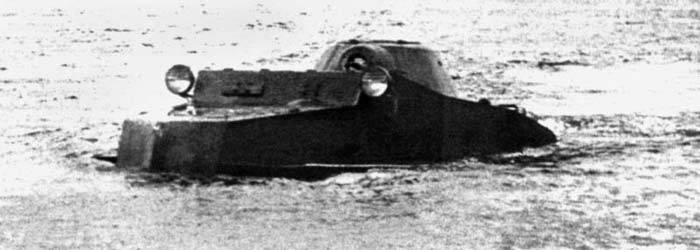
PB-7 on the water. Photo by Alternathistory.com
Initially, the only weapon of the PB-7 amphibious armored car was a rapid-firing aviation ShKAS machine gun. The ammunition of the machine gun, according to known data, was only 1000 rounds. The design of the tower provided firing in any direction with an elevation of more than 37 °. The decrease depended on the direction of fire. Forward, on top of the hull, it was possible to shoot at angles of no more than 2 °, sideways and backward - about 8 °. Other full-time weapons for the armored vehicle was not offered.
The crew of PB-7 consisted of only three people. In front of the corps located commander and driver. They could follow the road with inspection hatches with flaps in the front and side sheets. Above them there were hatches for landing in the car. The shooter was located in the tower, equipped with its own hatch and a set of viewing slots. Inside the habitable compartment there were free volumes suitable for placing additional ammunition.
Through the use of a new corps in the PB-7 project, it was possible to reduce the combat weight of the vehicle. This parameter was only 4,6 t, which should have a positive impact on driving performance and performance on the water. The armored car was 5,8 m in length, 2,15 m in width, the tower height was less than 2,1 m. According to calculations, on the highway it could reach 50 km / h speed and on water to 5 km / h. The fuel tanks on the 102 l gasoline provided a power reserve of 120 km.
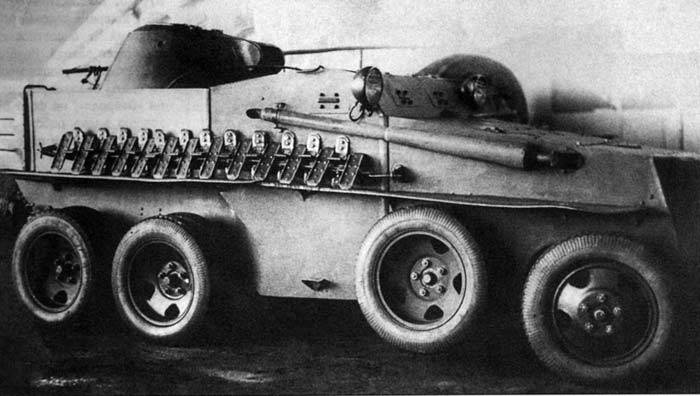
Armored car with reinforced weapons. Photo Aviarmor.net
The first experienced PB-7 armored car appeared in the early autumn of 1936. According to some information, some more cars were soon built, which in the near future were to participate in the trials. However, the size of the experimental batch of technology - if it existed - is unknown.
Until the summer of 1937, the prototype PB-7 was in factory testing and was refined. Approximately in the spring it was decided to re-equip the car. Instead of one ShKAS machine gun, it was proposed to use a twin installation with DT products. This could simplify the construction and operation of equipment while maintaining the desired fire qualities. In connection with the installation of new weapons had to rework the tower. Now she had a frontal detail with a round flow for a machine gun installation. Also on the roof of the hull, directly in front of the tower, a safety guide appeared, which did not allow to lower the stems below the permissible level. The 64 store with 4032 cartridges was placed on the racks of the fighting compartment.
During the factory inspections the armored car passed almost 2 thousand km and showed itself from a good side. After minor repairs and minor modifications, the car was presented for sea trials conducted with the participation of the Department for the Mechanization and Motorization of the Red Army. The first tests were conducted in November 1937.
To imitate work in real conditions, the armored car was loaded up to the calculated combat weight of 4,6 t, and also equipped with Overall chains. All subsequent tests, both on land and on water, were carried out in this configuration. For several weeks, the armored car went over land more than 580 km and confirmed its characteristics. In addition, he was checked on the water. In such circumstances, the car showed some flaws, but generally behaved with dignity.
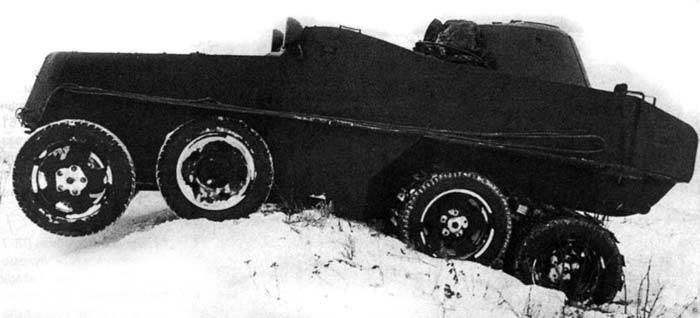
Armored car with chains "Overall" overcomes the obstacle. Photo by Alternathistory.com
The descent from the shore to the water and the exit back did not represent any particular difficulty, although it required a slope with a fairly hard bottom. The maximum speed on the water reached 4,55 km / h. Handling was normal. However, there were some problems with the power plant. So, attempts to go to direct transmission ended with the engine stopping. Propeller did not cause any complaints.
According to the test results of the end of 1937, the military made their decision. The proposed armored car had strengths and weaknesses, and needed some modifications. Thus, it was considered a problem that it was impossible to disconnect the drive of the propeller from crew jobs or from inside the hull. Also weak weapons were criticized. Instead of two machine guns of diesel pistol of rifle caliber, it was proposed to use a pair of large-caliber DC and less powerful diesel. This could provide an acceptable increase in firepower.
In the test report, it was noted that for the limited time allotted for inspections, the specialists could not comprehensively study the tactical and technical characteristics of the PB-7, and also determine its prospects as a combat unit. However, the military were able to learn the basic parameters of the machine and draw conclusions. A new armored car from the Izhora plant was considered profitable and suitable for use. After certain improvements, he could find a place in the army.
According to some data, at the beginning of 1938, specialists from KBM at the Izhora Works engaged in processing the existing project in accordance with the new wishes of the customer. They had to correct various minor technical and technological shortcomings. In addition, it was necessary to take into account the wishes of the customer regarding the design of the transmission and weapons. As far as is known, these tasks were successfully solved, and by a certain time an updated package of design documentation appeared.
In the near future, an order could be received for the mass production of armored vehicles with reinforced armament, but this never happened. At the turn of 1937 and 1938, the command of the Red Army changed its views on the development of a fleet of armored combat vehicles. The army still needed a new floating vehicle, but the direction of amphibious armored vehicles was now considered unpromising. In connection with this decision, all work in this area should be stopped. It should be noted that such an order affected only one piece of equipment - the armored vehicle PB-7.
Experienced PB-7 after the completion of the tests needed to be restored. In March, 1938 of the year - after the decision was taken to abandon the floating armored cars - it was repaired and handed over to the Leningrad armored personnel training courses. What happened to this car next - is unknown. Apparently, the only armored car of its type for some time was a training tool, and then was disposed of due to moral and physical obsolescence.
Development of domestic floating armored vehicles started in the early thirties and lasted for several years. Consistently created three cars that had these or other features. The first two samples of this family did not differ in high characteristics or simplicity of production, because of which a third project appeared. The armored car PB-7, in general, gave the military, but could not find a place in the army. He appeared too late, and at the time of the possible start of serial production, the command decided to abandon amphibians. The development of Soviet wheeled armored vehicles capable of swimming across water barriers stopped for a while.
Based on:
https://aviarmor.net/
http://alternathistory.com/
http://zonwar.ru/
http://arms-expo.ru/
Solyankin A. G., Pavlov M. V., Pavlov I. V., Zheltov I. G. Domestic armored vehicles. XX century. - M .: Exprint, 2002. - T. 1. 1905 – 1941
Kolomiets M.V. Armor on wheels. The history of the Soviet armored car 1925-1945. - M .: Yauza, Strategy KM, Eksmo, 2007.
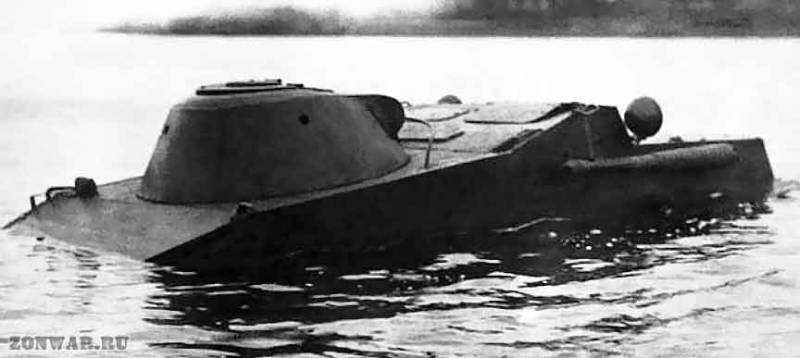
Information